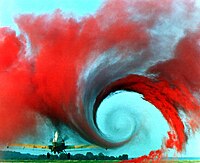
Photo from wikipedia
Abstract Understanding the trajectory of oil droplets in crossflow jets is important to estimate the pathways of hydrocarbons and to plan countermeasures. We report experimental results of an oil jet… Click to show full abstract
Abstract Understanding the trajectory of oil droplets in crossflow jets is important to estimate the pathways of hydrocarbons and to plan countermeasures. We report experimental results of an oil jet with release velocity around 1.5 m/s in a crossflow of 0.3 m/s. The hydrodynamics of the jets obtained with the Large Eddy Simulation (LES) were used to predict the migration of the oil droplets. Two Lagrangian techniques were explored, one with the inertia of the droplet is considered and the other that treats the droplets as massless particles with rising velocities corresponding to their size. We did not note a large difference between the two approaches. The droplets showed stronger segregation in the vertical direction, which renders the usage of a Gaussian distribution approximation in the vertical inapplicable. The dispersion coefficient at each direction was computed for different-sized droplets. The eddy diffusivity computed based on Boussinesq gradient approximation using the LES data was compared with the dispersion coefficients obtained based on Lagrangian tracking. We also found that droplets 500 μ m and larger escape the vortex while smaller ones get trapped within the vortex. A similar outcome was observed using a vortex trapping function based on inward-outward force balancing at the elevation of the vortex core. The counter-rotating vortex pair (CVP) altered the distribution of droplets of 1 mm and smaller significantly, and bimodal concentration distributions with peaks near the CVP vortex cores and minimum concentration near the center plane were obtained in the lateral-horizontal direction. Therefore, measurements of the oil droplet size distribution (DSD) in the center plane of crossflow jets could underestimate the number of small droplets in the whole plume.
Journal Title: Ocean Modelling
Year Published: 2020
Link to full text (if available)
Share on Social Media: Sign Up to like & get
recommendations!